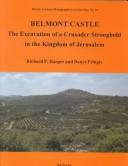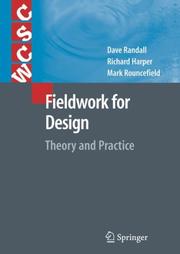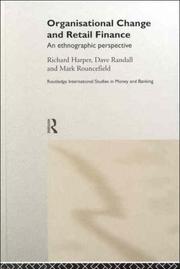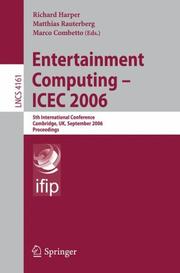| Listing 1 - 7 of 7 |
Sort by
|
Book
ISBN: 085729475X 0857294768 9786613570000 1280392088 Year: 2011 Publisher: London : Springer,
Abstract | Keywords | Export | Availability | Bookmark
 Loading...
Loading...Choose an application
- Reference Manager
- EndNote
- RefWorks (Direct export to RefWorks)
The title of this new book: “The Connected Home” reflects the move away from the idea that smart homes would alter the lives of those living in them by providing technologies to take over tasks that were previously the responsibility of the householder, such as managing entertainment, education – and even eating! Up until around 10 years ago this view was commonplace but time has shown that the technologies to support a smart home have not developed in such a way as to support this premise. Instead, what people do in their homes has moved the concept of a smart home into that of the ‘connected home’. The rise of on-line games technologies, video connections via Skype, social networking, internet browsing etc are now an integral part of the home environment and have had a significant effect on the home. The contributors to this exciting new book consider and discuss the effects and ramifications of the connected home from a variety of viewpoints: an examination of the take-up of personal computers and the Internet in domestic situations; an analysis of the changing intersection of technology and human habits in the connected home; the impact of gaming, texting, e-book readers, tablets and other devices and their effect on the social conditions of a household; the relationship between digital messaging applications and real geography; and an overview of how sensing technologies for the smart home might evolve (lightweight medical technologies for example). The book culminates by addressing unfinished ambitions from the smart home agenda, the factors that have prevented their realisation, and addresses the need for extending research into the area.
Computer science. --- Computers and families. --- Home automation. --- Home computer networks. --- Computers and families --- Engineering & Applied Sciences --- Electrical & Computer Engineering --- Computer Science --- Electrical Engineering --- Home economics. --- Domestic economy --- Domestic science --- Family and consumer sciences --- Household management --- Household science --- Computers and civilization. --- Personal computers. --- Computer Science. --- Personal Computing. --- Computers and Society. --- Family life education --- Home --- Consumer education --- Formulas, recipes, etc. --- Households --- Informatics --- Science --- Civilization and computers --- Civilization --- Home computers --- Micro computers --- Micros (Microcomputers) --- PCs (Microcomputers) --- Personal computers --- Small computers --- Minicomputers

ISBN: 9781739730253 9780197270097 Year: 2022 Publisher: Council for British Research in the Levant (CBRL)
Abstract | Keywords | Export | Availability | Bookmark
 Loading...
Loading...Choose an application
- Reference Manager
- EndNote
- RefWorks (Direct export to RefWorks)
This is the final definitive publication of the excavations that were conducted by the British School of Archaeology in Jerusalem on the site of the Crusader castle of Belmont (Suba), in the Judaean hills west of Jerusalem, between 1986 and 1989. The excavations and associated documentary research indicate that Belmont began its existence as a manor house or maison-forte in the first half of the twelfth century; at that time it probably represented the country seat of a fief-holding knight on the royal domain. By the 1140s, however, the areain which Belmont lay had been acquired by the Hospital of St John, which subsequently developed nearby Abu Ghosh (identified as biblical Emmaus) as the centre for an extensive estate. Following the Hospitallers takeover, while another former maison-forte, Aqua Bella, was converted into a priory orinfirmary building, Belmont was extended and developed as a concentric castle, dominating the landscape round about. A polygonal outer ward was added to the original rectangular maison-forte on the top of the hill, and ranges of vaulted buildings were constructed within it. This castle fell toSaladin in 1187, and was slighted by the Ayyubids in 1191. After this, the site was occupied by a village until 1948. The account of the excavation is preceded by a historical introduction and a discussion of the castles archaeological setting. It is followed by specialist reports on the coins and tokens, pottery, ceramic lamps, Persian seal impressions, glass, metalwork, clay tobacco pipes, and objects of stone,bone and terracotta. A detailed analysis and discussion is provided of the faunal remains; and a concluding chapter discusses the castles architecture and planning, its military functions, and its economic role within an agricultural estate that developed in the the later twelfth century to producefood and revenue for the Hospital in Jerusalem.
Excavations (Archaeology) --- Archaeological digs --- Archaeological excavations --- Digs (Archaeology) --- Excavation sites (Archaeology) --- Ruins --- Sites, Excavation (Archaeology) --- Archaeology

ISBN: 1280283270 9786610283279 1402030606 1402030592 9048167809 Year: 2005 Publisher: Dordrecht : Springer,
Abstract | Keywords | Export | Availability | Bookmark
 Loading...
Loading...Choose an application
- Reference Manager
- EndNote
- RefWorks (Direct export to RefWorks)
SMS or Text is one of the most popular forms of messaging. Yet, despite its immense popularity, SMS has remained unexamined by science. Not only that, but the commercial organisations, who have been forced to offer SMS by a demanding public, have had very little idea why it has been successful. Indeed, they have, until very recently, planned to replace SMS with other messaging services such as MMS. This book is the first to bring together scientific studies into the values that ‘texting’ provides, examining both cultural variation in countries as different as the Philippines and Germany, as well as the differences between SMS and other communications channels like Instant Messaging and the traditional letter. It presents usability and design research which explores how SMS will evolve and what is likely to be the pattern of person-to-person messaging in the future. In short, The Inside Text is a fundamental resource for anyone interested in mobile communications at the start of the 21st Century.
Personal communication service systems --- Wireless communication systems. --- Social aspects. --- Communication systems, Wireless --- Wireless data communication systems --- Wireless information networks --- Wireless telecommunication systems --- Telecommunication systems --- PCS systems --- Personal telecommunication systems --- Personal wireless communication systems --- Personalized communication services --- Wireless personal communication systems --- Wireless communication systems --- Information Technology --- Computer Science (Hardware & Networks) --- Computer science. --- Architectural design. --- Anthropology. --- Computer Science, general. --- User Interfaces and Human Computer Interaction. --- Interaction Design. --- Sociology, general. --- Human beings --- Design --- Structural design --- Informatics --- Science --- User interfaces (Computer systems). --- Graphic design. --- Sociology. --- Social theory --- Social sciences --- Interfaces, User (Computer systems) --- Human-machine systems --- Human-computer interaction --- Primitive societies

ISBN: 1280852909 9786610852901 1846287685 1846287677 1849966478 Year: 2007 Publisher: London : Springer,
Abstract | Keywords | Export | Availability | Bookmark
 Loading...
Loading...Choose an application
- Reference Manager
- EndNote
- RefWorks (Direct export to RefWorks)
Fieldwork for Design looks at why ethnographic approaches have been turned to in the design of computing devices for the workplace, for the home and elsewhere. It presents a history of ethnography, both as it was practiced before computer science picked it up and since, most especially in the CSCW and HCI domains. It examines, further, the various ethnographic or ‘fieldwork’ frameworks currently popular, explaining and examining what each claims and entails. The focus of the book throughout is on the practical relationship between theory and practice, a relationship that is often misunderstood yet fundamental to successful design. The book is illustrated with real examples from the authors’ various experiences in academic and commercial settings, reporting on the use of ethnography before, during and after design innovation and implementation. The result is a book that provides the working knowledge necessary for using any kind of ethnographic approach in the design of computer technologies. Written to provide an overview of the topic for researchers and graduates, as well as practitioners, this book will prove an invaluable resource for all in the field. As an HCI researcher and practitioner, I am delighted to see, at last, a balanced view about the practice of ethnography within our field. Gary Marsden, Associate Professor of HCI, University of Cape Town, South Africa Dave Randall is Senior Lecturer at Manchester Metropolitan University, UK Richard Harper is a Senior Researcher for Microsoft Mark Rouncefield is a Senior Research Fellow at Lancaster University.
Human-computer interaction --- User-centered system design. --- Ethnology. --- Social aspects. --- Cultural anthropology --- Ethnography --- Races of man --- Social anthropology --- Anthropology --- Human beings --- Cognitive engineering (System design) --- Participatory design (System design) --- UCD (System design) --- Usability engineering (System design) --- User-centered design (System design) --- System design --- Computer-human interaction --- Human factors in computing systems --- Interaction, Human-computer --- Human engineering --- User-centered system design --- User interfaces (Computer systems) --- Computer science. --- User Interfaces and Human Computer Interaction. --- Informatics --- Science --- User interfaces (Computer systems). --- Interfaces, User (Computer systems) --- Human-machine systems

ISBN: 1134632002 1280330813 9786610330812 0203257146 0203029992 0415202647 9780203257142 9780203029992 9781134632008 9780415202640 9781134631957 9781134631995 Year: 2000 Publisher: London New York Routledge
Abstract | Keywords | Export | Availability | Bookmark
 Loading...
Loading...Choose an application
- Reference Manager
- EndNote
- RefWorks (Direct export to RefWorks)
Financial organizations, like many others, are undergoing radical change. This is affecting both their organizational processes and the technology that supports those processes. This book reports on the use of sociological ethnography in helping guide these changes, both in terms of helping better understanding and redraw work processes and through providing more accurate and flexible understanding of the role technology plays. It places the reported research in context by contrasting it with those approaches more commonly associated with change, including business process engineering, partici
Bank management. --- Bank management --- Banks and banking --- Management --- E-books
Book
Year: 2019 Publisher: Amsterdam : John Benjamins Publishing Company,
Abstract | Keywords | Export | Availability | Bookmark
 Loading...
Loading...Choose an application
- Reference Manager
- EndNote
- RefWorks (Direct export to RefWorks)
"This collection is one of the first in-depth studies of video calling in family and domestic life. It explores the reasons that people themselves provide to explain their video calling, investigates how these reasons make that calling accountable and how, in turn, these reasons come to be things talked about in the calls themselves. The research shows how video calling is part of the currency of contemporary family affection: such calls are not just about keeping in touch, they are a way of loving too; and they are sometimes a way of fighting as well. 'Skyping' or 'Facetiming' might be frequent and can seem mundane - just a question of routine - but what they entail is a measure of important things to families. This makes this collection of interest to anyone concerned with family life and the evolving ways in which technology has a role in it. Originally published as a special issue of Pragmatics 27:3 (2017)"-- Provided by publisher.

ISBN: 9783540452591 3540452591 3540452613 Year: 2006 Publisher: Berlin ; New York : Springer,
Abstract | Keywords | Export | Availability | Bookmark
 Loading...
Loading...Choose an application
- Reference Manager
- EndNote
- RefWorks (Direct export to RefWorks)
Welcome to the proceedings of ICEC 2006 Firstly, we are pleased with the solid work of all the authors who contributed to ICEC 2006 by submitting their papers. ICEC 2006 attracted 47 full paper submissions, 48 short paper submissions in total 95 technical papers. Based on a thorough review and selection process by 85 international experts from academia and industry as members of the Program Committee, a high-quality program was compiled. The International Program Committee consisted of experts from all over the world: 2 from Austria, 1 from Canada, 3 from China, 3 from Finland, 3 from France, 11 from Germany, 2 from Greece, 2 from Ireland, 5 from Italy, 10 from Japan, 1 from Korea, 7 from Netherlands, 2 from Portugal, 1 from Singapore, 3 from Spain, 3 from Sweden, 1 from Switzerland, 15 from UK, and 14 from USA. The final decision was made by review and conference chairs based on at least three reviewers' feedback available online via the conference management tool. As a result, 17 full papers and 17 short papers were accepted as submitted or with minor revisions. For the remaining submissions, 28 were recommended to change according to the reviews and were submitted as posters. This proceedings volume presents 62 technical contributions which are from many different countries: Belgium, Canada, P. R. China, Denmark, Finland, France, Germany, Italy, Japan, Korea, The Netherlands, Portugal, Singapore, Spain, Sweden, Taiwan, the UK, and USA.
Entertainment computing --- Divertissement informatique --- Congresses. --- Congrès --- Computer Science --- Engineering & Applied Sciences --- Computer science. --- Multimedia information systems. --- User interfaces (Computer systems). --- Artificial intelligence. --- Computer graphics. --- Application software. --- Computer Science. --- User Interfaces and Human Computer Interaction. --- Information Systems Applications (incl. Internet). --- Multimedia Information Systems. --- Artificial Intelligence (incl. Robotics). --- Computer Graphics. --- Computer Appl. in Arts and Humanities. --- Application computer programs --- Application computer software --- Applications software --- Apps (Computer software) --- Computer software --- Automatic drafting --- Graphic data processing --- Graphics, Computer --- Computer art --- Graphic arts --- Electronic data processing --- Engineering graphics --- Image processing --- AI (Artificial intelligence) --- Artificial thinking --- Electronic brains --- Intellectronics --- Intelligence, Artificial --- Intelligent machines --- Machine intelligence --- Thinking, Artificial --- Bionics --- Cognitive science --- Digital computer simulation --- Logic machines --- Machine theory --- Self-organizing systems --- Simulation methods --- Fifth generation computers --- Neural computers --- Interfaces, User (Computer systems) --- Human-machine systems --- Human-computer interaction --- Computer-based multimedia information systems --- Multimedia computing --- Multimedia information systems --- Multimedia knowledge systems --- Information storage and retrieval systems --- Informatics --- Science --- Digital techniques --- Amusements --- Multimedia systems. --- Information systems. --- Artificial Intelligence.
| Listing 1 - 7 of 7 |
Sort by
|

 Search
Search Feedback
Feedback About UniCat
About UniCat  Help
Help News
News